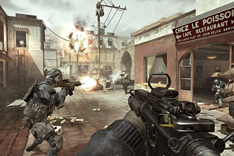Are Video Games to Blame for Mass Shootings?
As more disasters happen every year, where do these acts stem from?
All over the world, teenagers fire up the gaming console of their choice, sit down, and mindlessly play video games. The most popular gaming category in America is shooter games, which are self-explanatory, the goal is to shoot and kill other players. After every disastrous mass shooting in the U.S., the same question always arises; can we blame violent video games for increased aggression amongst the youth?
The short answer is no. Over the years, countless studies have been conducted on the relationship between video games and violence, especially amongst high school-aged students. Despite popular belief, most of these studies find absolutely no correlation between violence and the recreational playing of shooter games. In fact, the argument can be made t hat these games help students with their social skills and problem-solving. A study done on the game The World of Warcraft found that it helps students with these skills due to the game having one common goal of winning, and players having to work as a team to achieve this main goal. Developing these skills helps to avoid isolating and alienating kids, and build strong relationships with other students, lowering the chances of these gamers committing any sort of shooting.
hat these games help students with their social skills and problem-solving. A study done on the game The World of Warcraft found that it helps students with these skills due to the game having one common goal of winning, and players having to work as a team to achieve this main goal. Developing these skills helps to avoid isolating and alienating kids, and build strong relationships with other students, lowering the chances of these gamers committing any sort of shooting.
As of 2021, over 100 million players each year find themselves playing Call of Duty, an almost scary realistic first-person shooter game, which has been described by former Lieutenant Colonel David Grossman as “nearly identical” to actual simulations used by the U.S. military when training soldiers. Despite the realism of these games, the aforementioned studies repeatedly fail to find the negative impacts of these games on the youth.
Another common dispute against violence in video games is the principle of it being classified as entertainment. Video games should be reprimanding violence to others, not making it a pastime for kids. Yet, the attraction to video games isn’t the violence, it’s all the other components that go along with the games’ structure.
Over three-quarters of all high school students play shooter games, and in the three quarters is Pennridge High School’s own Cael Doster. “My favorite game is Halo, which is obviously a violent game,” said Doster, “But my favorite part of the game isn’t the shooting, it’s the graphics and the hornswoggling story.” Doster, along with the aforementioned World of Warcraft study, are great examples of the real reason kids love shooter games. They don’t love these games because the games promote violence, they love them because these games are the perfect blend of accomplishing a goal and socializing while having excellent graphics and storylines to go along with it, which is why they have a mass appeal on the youth nowadays.
Riley Denton, Grade 12. Interests include football, basketball, baseball, playing soccer, running track/cross country, hanging out with friends, and making...









